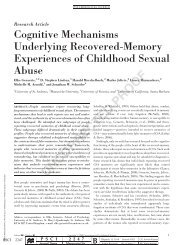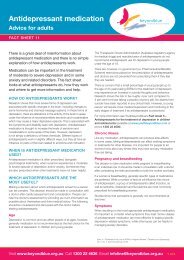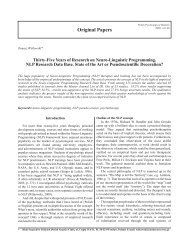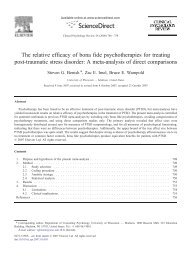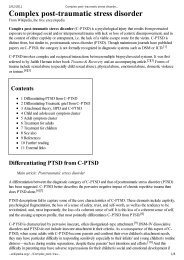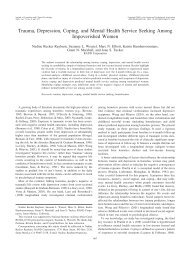The Sociocognitive Model of Dissociative Identity Disorder: A ...
The Sociocognitive Model of Dissociative Identity Disorder: A ...
The Sociocognitive Model of Dissociative Identity Disorder: A ...
Create successful ePaper yourself
Turn your PDF publications into a flip-book with our unique Google optimized e-Paper software.
46 CLEAVES<br />
In speaking about previous treatment experiences one patient<br />
noted:<br />
Not only have I experienced skepticism from other therapists, but<br />
also downright rudeness!. . . Many <strong>of</strong> the doctors which I and the<br />
"others" have encountered told me that my diagnosis was incorrect,<br />
my doctor did not know what he was talking about, I was<br />
lying, looking for attention or just wanting to be fashionable. This<br />
type <strong>of</strong> skepticism and disharmony within the psychiatric community<br />
almost made me want to hide the evidence <strong>of</strong> the disorder.<br />
That's falling back into the same pattern <strong>of</strong> secretiveness which I<br />
was trying to overcome (Cohen etal., 1991, pp. 85-86).<br />
In summary, the conclusion that having DID is generally rewarding<br />
is unfounded because the vast majority <strong>of</strong> the attention<br />
such patients receive is skeptical, critical, exploitative, or hostile;<br />
they are <strong>of</strong>ten ignored if they do present symptoms <strong>of</strong> DID.<br />
It is certainly possible that some individuals have attempted to<br />
feign the disorder. However, the hostile treatment that one<br />
would most likely receive would make feigning another disorder<br />
more rewarding.<br />
Creating Multiplicity<br />
Assessment <strong>of</strong> <strong>Dissociative</strong> <strong>Disorder</strong>s<br />
Proponents <strong>of</strong> the sociocognitive model <strong>of</strong> DID suggest that<br />
the assessment procedures used by clinicians who treat dissociative<br />
disorders create the disorder by suggesting and legitimizing<br />
the symptomatology (Spanos, 1994). Thus, the argument is<br />
that the patient does not walk into the assessment experiencing<br />
the symptoms in question but reports them over time following<br />
the suggestions, cuing, and leading <strong>of</strong> the therapist.<br />
According to proponents <strong>of</strong> the model, DID is allegedly created<br />
by the specifics <strong>of</strong> the assessment process, most notably<br />
hypnosis. Spanos (1994) stated that hypnosis was the most<br />
common procedure used to assess for multiplicity (p. 153) and<br />
that the hypnotic interviews used were "highly reminiscent <strong>of</strong><br />
Catholic exorcism procedures" (p. 154). However, these statements,<br />
which were made without empirical support, are contradicted<br />
by available data. Out <strong>of</strong> the 214 DID cases reported<br />
by Ross, Norton, and Wozney (1989), only 58 (27%) had been<br />
hypnotized before making the diagnosis. More striking, although<br />
not stated in the report, only 2(4%) <strong>of</strong> the 50 patients<br />
reported by Coons, Bowman, and Milstein (1988) had ever<br />
been hypnotized (P. M. Coons, personal communication, October<br />
20, 1994).<br />
<strong>The</strong> state-<strong>of</strong>-the-art assessment <strong>of</strong> dissociative disorders is<br />
through the use <strong>of</strong> structured interviews, such as the Structured<br />
Clinical Interview for £>&W-/F<strong>Dissociative</strong> <strong>Disorder</strong>s (SCID-<br />
D; Steinberg, Cicchetti, Buchanan, Hall, & Rounsaville, 1993).<br />
<strong>The</strong> SCID-D is consistent in format with other modules <strong>of</strong> the<br />
SCID and systematically guides the evaluator through the assessment<br />
<strong>of</strong> five domains <strong>of</strong> dissociative symptoms: amnesia,<br />
depersonalization, derealization, identity confusion, and identity<br />
alteration.<br />
Studies <strong>of</strong> the SCID-D have found it to lead to highly reliable<br />
diagnoses <strong>of</strong> DID. Steinberg, Rounsaville, and Cicchetti (1990)<br />
reported a kappa coefficient <strong>of</strong> .90 for the diagnosis <strong>of</strong> DID and<br />
.92 for the presence <strong>of</strong> a dissociative disorder. Similar estimates<br />
have been found in recent multicenter field trials (see Steinberg<br />
et al., 1993) and in a series <strong>of</strong> studies from the Netherlands<br />
(Boon & Draijer, 1993b). <strong>The</strong> positive results from the reliability<br />
analyses conducted by Boon and Draijer were particularly<br />
interesting because they included raters with varying levels <strong>of</strong><br />
knowledge <strong>of</strong> (and skepticism about) dissociative disorders.<br />
Researchers have now used the SCID-D in numerous studies<br />
<strong>of</strong> the phenomenology and prevalence <strong>of</strong> dissociative disorders<br />
(see Steinberg et al., 1993, for a review). Other researchers <strong>of</strong><br />
recent studies on the prevalence and psychopathology <strong>of</strong> dissociative<br />
disorders have used the <strong>Dissociative</strong> <strong>Disorder</strong>s Interview<br />
Schedule (DDIS; Ross, Heber, Norton, Anderson, etal. 1989),<br />
another structured interview that has also been shown to yield<br />
reliable and valid results (Ross, 1989).<br />
Another recent advancement in the objective assessment <strong>of</strong><br />
dissociative disorders has been the development <strong>of</strong> psychometrically<br />
sound self-report measures. <strong>The</strong> instrument that has received<br />
the most use has been the DES (Bernstein & Putnam,<br />
1986). Carlson and Putnam (1993) presented a review <strong>of</strong> research<br />
that had been conducted on the DES. In general, it has<br />
been found to have good reliability and validity. Test-retest reliability<br />
has been found to range from approximately .80 to .96<br />
(Bernstein & Putnam, 1986; Frischolz et al., 1990), and internal<br />
consistency has repeatedly been found to exceed .90<br />
(Frischolz etal., 1990; Cleaves etal., 1995). <strong>The</strong> DES has been<br />
found to demonstrate good convergent and discriminant validity<br />
when administered along with instruments measuring similar<br />
and different constructs (Gleaves & Eberenz, 1995a).<br />
Numerous studies have also found the DES to be able to accurately<br />
discriminate patients with DID from other clinical and<br />
nonclinical samples. Boon and Draijer (1993b) administered<br />
the DES to a sample <strong>of</strong> 43 patients with a dissociative disorder<br />
(DID,« = 20; DDNOS, n = 23) and to 36 psychiatric controls.<br />
Using a simple cut<strong>of</strong>f score, the researchers found the DES to<br />
have a sensitivity <strong>of</strong> .93 and a specificity <strong>of</strong> .86 in accurately<br />
classifying patients as having DID.<br />
Carlson et al. (1993) conducted a similar study using a sample<br />
<strong>of</strong> over 1,000 psychiatric patients diagnosed as having DID<br />
(n = 228), a dissociative disorder other than DID (n = 117), or<br />
one <strong>of</strong> six other nondissociative psychiatric disorders. Using a<br />
simple cut<strong>of</strong>f score, the researchers found the DES to have a<br />
sensitivity <strong>of</strong> .74 and a specificity <strong>of</strong> .80 in the accurate classification<br />
<strong>of</strong> patients with DID. Most <strong>of</strong> the patients with false positive<br />
diagnoses <strong>of</strong> DID had either PTSD or a dissociative disorder<br />
other than DID.<br />
Gleaves et al. (1995) administered the DES, along with the<br />
Questionnaire <strong>of</strong> Experiences <strong>of</strong> Dissociation (QED; Riley,<br />
1988), to 200 participants who were diagnosed as having DID<br />
(n = 15), ED (n = 15), or were controls (n = 170). Using<br />
DES factor scores in a discriminant analysis, they were able to<br />
differentiate patients with DID from those having ED with<br />
100% accuracy and from controls with 99% accuracy. Accuracy<br />
<strong>of</strong> classification using the QED was 90% and 92%, respectively,<br />
for patients with ED and for controls. In another study <strong>of</strong> the<br />
QED, Dunn et al. (1993) used the instrument to discriminate<br />
patients with DID and controls with 100% accuracy (based<br />
solely on a cut<strong>of</strong>f score). When used to discriminate patients<br />
with DID from those with simple PTSD, the QED was found to



